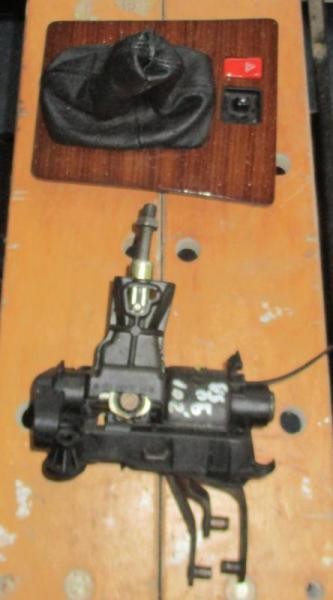For enthusiasts of classic Mercedes-Benz models like the W201 and W124, the tactile engagement of a manual transmission is a key part of the driving experience. However, over time, the precision and feel of the 5-speed shifter can degrade, leading to issues like difficulty engaging 5th gear or reverse. If you’re experiencing a notchy or imprecise shifter in your vintage Mercedes, refurbishment can significantly improve its performance. This guide will walk you through the process of removing and disassembling your Mercedes Shifter, focusing on the common 5-speed manual gearbox found in W201 and W124 models.
Symptoms of a worn Mercedes shifter often include vague engagement of 5th gear and reverse. You might find yourself needing to double-clutch or apply extra force to shift smoothly. While these symptoms could indicate more serious gearbox issues like synchromesh wear, often the culprit is simply wear and tear in the shifter mechanism itself. Before diving into complex transmission repairs, addressing the shifter is a logical first step.
The shifter assembly in these Mercedes models is a mechanical linkage system, and like any mechanical system, its components can wear out over time. Bushings can degrade, lubrication can dry out, and small parts can become loose or damaged. Refurbishing the shifter involves cleaning, inspecting, and replacing worn components to restore its original smooth and precise operation.
Shifter Removal: A Straightforward Process
Removing the Mercedes shifter is a relatively simple task, accessible to most DIY mechanics. If you’re at all familiar with basic automotive disassembly, you should find this stage quite manageable.
Mercedes W201 shifter assembly detached from its mounting position, ready for refurbishment.
Before proceeding further with the shifter removal, it’s advisable to disconnect the reverse light switch. This small electrical component is typically attached to the shifter assembly and can be easily damaged if left connected during removal.
Pre-disassembly step: Detaching the reverse light switch from the Mercedes shifter mechanism to prevent damage during handling.
With the reverse light switch safely disconnected, you can now move on to disassembling the shifter itself.
Disassembling the Mercedes Shifter: Step-by-Step
The disassembly process reveals the inner workings of the Mercedes shifter and allows for a thorough inspection of its components.
Initial disassembly of the Mercedes shifter, showcasing the first components exposed after opening.
Two 10mm bolts are the first fasteners you’ll encounter. Removing these bolts initiates the disassembly sequence.
Removing the initial pair of 10mm bolts that secure parts of the Mercedes shifter mechanism.
Be mindful that the shifter mechanism is spring-loaded. However, the spring pressure is not excessive, and disassembly is safe and straightforward.
Illustration of the Mercedes shifter’s spring mechanism, demonstrating the controlled release during disassembly.
As components are removed, they come apart cleanly, revealing the next layer of the mechanism.
Further disassembly showing the clean separation of Mercedes shifter components.
The levers that connect to the shifter rods are removed as a group. Pay close attention to the orientation and arrangement of washers and spring washers during this stage. While Mercedes-Benz EPC diagrams are helpful, noting the original configuration is invaluable for reassembly.
Organization of removed levers and washers from the Mercedes shifter, essential for correct reassembly.
Using a glove can aid in keeping components organized and contained during disassembly.
Practical tip: Employing a glove to keep small Mercedes shifter parts together and prevent loss.
Small components can sometimes remain attached even after initial disassembly steps, requiring careful attention.
Detail of a smaller component still connected to the Mercedes shifter, emphasizing the need for thoroughness.
A clear plastic end cap is another component that can be removed during disassembly.
Detaching the clear plastic end cap of the Mercedes shifter, part of the complete disassembly process.
Fiddly C-clips retain a pin within the shifter mechanism. These can be carefully removed using small electrical screwdrivers.
Step-by-step C-clip removal from the Mercedes shifter pin, critical for further disassembly.
These small C-clips should be kept safe, even though replacement clips are typically included in a shifter repair kit.
Internal components of the Mercedes shifter exposed following the removal of C-clips and pins.
Next, two Torx screws need to be removed. Initially, marking the position of components on the shaft might seem beneficial, but as it turns out, this step isn’t strictly necessary for reassembly.
Complete disassembly of the Mercedes shifter, with all parts separated for cleaning, inspection, and potential replacement.
While precise measurements were taken during the original process, it’s noted that these measurements are ultimately not crucial for successful refurbishment. However, for those who prefer to document every step meticulously, these measurements can offer additional reassurance.
A Mercedes-Benz shifter repair kit is available to aid in refurbishment.
Mercedes-Benz shifter refurbishment kit, containing parts typically needed for a comprehensive overhaul.
It’s important to verify that the part number of the repair kit (e.g., 1242602539) is correct for your specific shifter type, as variations exist depending on the model year and transmission configuration. Some kits might be designed for different reverse gear positions, so double-checking compatibility is essential before ordering. Even if a kit isn’t a perfect match, it may still contain many of the necessary components and can often be adapted with minor modifications, potentially saving a trip to the dealership for less common parts.
By following these steps, you can effectively disassemble your Mercedes-Benz W201 or W124 5-speed shifter, preparing it for cleaning, inspection, and refurbishment. Restoring your shifter can significantly enhance the driving experience of your classic Mercedes, bringing back the satisfying and precise gear changes these cars are known for.

